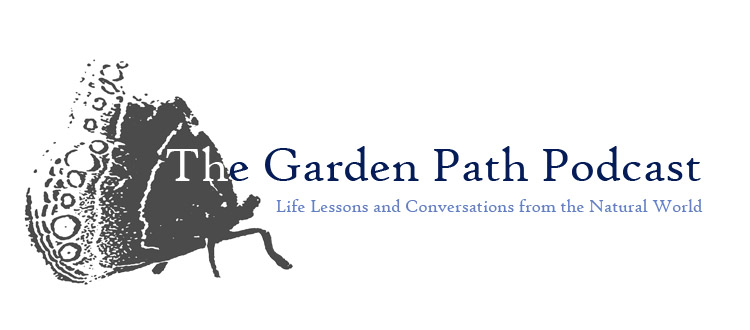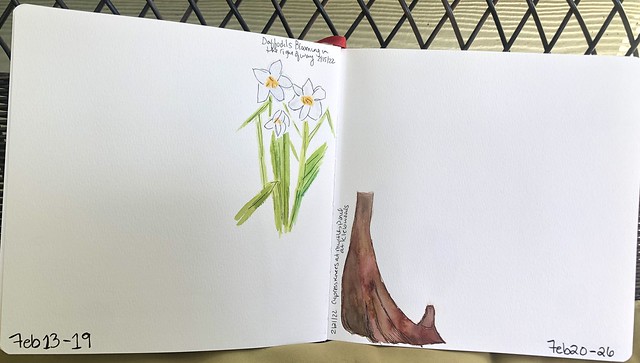Episode Transcript (more or less)
Welcome to the Garden Path Podcast, Life Lessons and Conversations from the natural world. I’m your host Misti Little.
Back in the 6th grade I was introduced to the world of art via an elective in middle school. I had played the oboe in the band for my first semester in middle school but after deciding that buying double reeds every few months was going to get expensive, and the fact I wasn’t that interested in practicing, I switched my elective to art the following semester. I was hooked from the get-go, with the wonderful Mrs. Walker, my art teacher who taught us about pointillism and expressionism and everyone before and art as we made our own art that year. I loved it so much I continued on with it every year in middle school and eventually submitted my portfolio to be judged into the honors art program in highschool. Eventually I lettered in art my senior year but I knew that I struggled with the quality of my work because of that same pesky thing I had dealt with in band—the lack of practice! And if I thought double reeds were expensive, did you know how much good art supplies cost?
My life diverged from art when I went to college but much like my love for reading, I would find my way back to it now and again during those four years. I continued dabbling around with art after college and then with my own money and more free time I had the opportunity to study it for myself and play around with different media. In highschool I had loved mixed media, and I still do, but then I found myself in love with oil painting and soft pastels. It was easy to become a collector of art supplies with a discount coupon to Michaels and a keen eye for the clearance racks there! Watercolor was always a subject that seemed to defy me, though, and one in which I didn’t enjoy nearly as much as I did oils and acrylics. A loose pastel was about a free form as I wanted to be. But I still found myself drawn to watercolors.
Back in the 2000s I would pilfer through WetCanvas, an online forum for art enthusiasts, and through blogs, to gain inspiration. Both of those still exist but as Instagram took over our lives in social media I created a special account just for my art and to follow artists of interest. I originally became aware of nature journaling from my friend Kate Dolamore who was a guest in November 2019 on the podcast. I had always admired her art journals that she shared every month, which chronicled the nature she saw while hiking. And she’s such a talented watercolorist that it made me intrigued to find out if I could master watercolors for myself.
Sometime in the spring of 2021 I started following more watercolorists and nature journalers on my Instagram account and then later that summer I found the most delightful podcast called Journaling with Nature. I devoured the episodes from Australian Bethann Burton and really began diving into what the world of nature journaling was all about. A lot of nature journalers work in watercolor but a fair number use pen and ink or brush pens to accomplish their artwork. And I had always loved the idea of actually completing a full sketchbook. I had several half completed sketchbooks but never a full one.
Finally, I decided to commit to it. A real nature journal for myself, which I started in September of 2021. So, what is nature journaling you ask?
It sounds simple, and it is—but there are many variations, but the most important part is to make it your own. In a blog post from the International Nature Journaling Week, also created by Bethann Burton, “Nature journaling is the practice of drawing or writing in response to nature”. In other words, we sit, observe, draw, and make notes on what we experience in nature. There are so many things to tell you about nature journaling so I will start by talking about my own nature journaling this last year and then delve into the who’s who of nature journaling and how you can get started on your own.
When we moved into our house we started keeping a small notebook for noting interesting animal sightings. We kept track of it for a while, or rather my husband did, but it did fall by the wayside. And then several years ago I heard on Margaret Roach’s podcast an interview about the Naturalist’s Notebook, a way to write down and observe nature for yourself in a 5-year perpetual calendar sort of way. Unfortunately during this last year I found that I was tired of dealing with the small note spacing for each day and that I really was bad about keeping up with it! That book is actually very interesting in other aspects because the authors do provide many tidbits about noticing nature that you can easily incorporate into your own nature journal, but again, the spacing and writing only portion didn’t work for me. Plus, as an avid blogger, my blog posts are almost my archive for observations. I don’t blog nearly as much as I used to but that is still a valuable source of information. Maybe someday I will do something with those posts.
Which is where nature journaling came into play. I wanted to work on a sketchbook habit and also wanted to document the nature around me and I came up with a plan. I set up an Arteza watercolor sketchbook, an 8.25×8.25 sized journal, I’ll put the link in the show notes for you, as it provided enough pages for me to set up one week for each page and then have a few extra pages later for notes or watercolor swatches or whatever. It also has a handy clear pocket on the inside back for any ephemera you may want to put in there. I have some extra pages left at the end and am using it for yearly reflection notes but you could also use it for paint swatches or to draw other things that you may not want to put on the main pages.
A year into this I am realizing that you can be as flexible as you want to be with it. My goal is to just start creating a practice so that means I am often drawing from photos I took during the week and not out in nature itself. I don’t always have the time to sit and paint something for thirty or 45 minutes so sometimes it is easier to do it when I have the time later. I also keep my note taking to a minimum, mainly noting the plant or animal I painted and a short sentence about it. Many nature journalers get more detailed in their note taking, including weather, wind patterns, detailed notes on the subject they are studying. It really does vary.
As I mentioned, the medium involved can be dependent on personal preferences and I chose watercolor to strengthen my watercolor skills. But people use pen and ink, pencil, or markers. If you choose watercolors I suggest using something other than a beginner set. I originally began using a Winsor and Newton Cotman set but overtime I realized I didn’t really like the way the paint was working on the paper. I have since broadened out into the Art Philosophy watercolor sets as there are many different pallets and they are affordably priced. A bit better than beginner paints, they won’t break your budget as some more professional grade paints might. I definitely enjoy them, though they do have their limits, too. I also have some tubes of Daniel Smith watercolors, a professional line, and enjoy those as well. Over this year I have found that working from photographs worked best but hope that this coming year I can find time to get outside and work in the journal from nature more often!
Earlier I mentioned Bethann Burton and her podcast but there is a wide world of nature journalers out there to gain inspiration from. The biggest name is probably John Muir Laws, a naturalist and educator who has written countless books, both on nature journaling and field guides, and teaches classes both online and in person throughout the year. I highly recommend diving into his YouTube channel for a trove of information he has to offer! He has also done a podcast series with artist Danny Gregory this last year, the Art for All podcast. Danny is also someone you should check out if you are at all interested in keeping a sketchbook beyond a nature journal. Also on YouTube and through a newsletter, I like to catch Marley Pefier’s videos when they are out.
In book land, Clare Walker Leslie is hailed as the go-to, along with John Muir Laws, for nature journaling. While I have not read any of her books I have heard countless people on podcasts talk about her so I know she is someone worth reading and learning from. There really are so many wonderful people doing great nature journaling work out there! I’ll share a list of them in the show notes so that you can check them out!
One thing I enjoyed noticing this year was realizing that the cardinal flowers were about to bloom when I flipped back to the first entry from last year, the first week of September. It was a fantastic reminder that the seasons change and everything has its season and we get a chance to enjoy it again. Documenting it in photographs is one thing but taking the time to put it down on paper and write a little bit about it commits that moment to memory, possibly more than it would have if you had snapped a photo on the go.
So, I encourage you to start your own nature journal or at least start sketching here and there what is going on in nature around you. You don’t need to wait for the right moment or for a few year to begin. I started mine in September last year! And life isn’t always favorable for keeping up with it, that’s why it is so easy to look at a photo a few weeks later to catch up.
I’ll share a few entries of my own journal on the show notes for the podcast along with the links that I mentioned above at thegardenpathpodcast.com If you want to chat about nature journaling or have questions, feel free to email me at thegardenpathpodcast at gmail.com
That’s it for the episode, I hope it inspired you just a little bit! Thanks for listening and happy gardening
Show Notes:
+Art Philosophy Watercolors
+Daniel Smith Watercolors
+Arteza Sketchbooks
+John Muir Laws
+Danny Gregory
+We Are Stardust
+A Wild Braid
+Journaling with Nature – Bethann Burton
+International Nature Journaling Week





